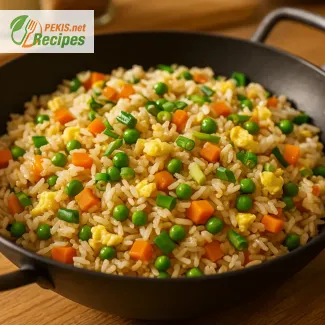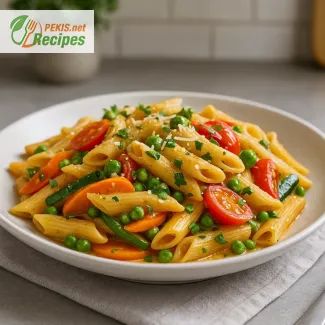
Soothing chicken and rice soup for sensitive digestion
A gentle comfort meal for gastrointestinal relief and healing
Crafted for those who seek digestive relief without sacrificing warmth and nourishment, this low-residue chicken rice soup is more than just a comforting bowl—it’s a therapeutic recipe designed to ease the gastrointestinal tract. Whether you’re recovering from gastrointestinal distress, managing inflammatory bowel disease (IBD), healing post-surgery, or supporting a loved one through a sensitive dietary period, this dish provides a careful balance of digestive gentleness and nutritional simplicity.
Unlike typical brothy soups, this low-fiber chicken soup excludes rough ingredients such as fibrous vegetables, legumes, and whole grains that may irritate or burden the gut. Instead, it centers on tender chicken, white rice, and strained broth, combining easily digestible proteins and carbohydrates that are known to soothe the digestive system. Every element in this soup is chosen with intention—to be low in residue, mild in flavor, and free from irritants, offering the digestive tract a moment of rest.
What makes this soup low-residue?
A low-residue diet is specifically formulated to reduce the frequency and volume of stool by limiting fiber and other components that are harder to digest. This type of diet is often recommended for individuals experiencing acute digestive conditions, recovering from bowel surgery, or preparing for a colonoscopy. It eliminates high-fiber vegetables, seeds, nuts, and dairy with lactose, replacing them with refined grains, lean proteins, and clear broths.
In this recipe, you’ll find no onions, garlic, celery, or herbs with skins or seeds. Instead, the focus is on peeled, well-cooked carrots (if tolerated), plain white rice, and skinless chicken breast, all simmered slowly in a strained, clear broth to maintain hydration and replenish electrolytes while resting the bowel.
Who benefits from a low-residue chicken rice soup?
This gentle, easy-to-digest chicken soup is especially suitable for:
- Individuals with Crohn’s disease, ulcerative colitis, or diverticulitis during flare-ups
- Patients in postoperative recovery from gastrointestinal procedures
- People experiencing nausea, diarrhea, or abdominal pain
- Those preparing for or recovering from a colonoscopy or GI exam
- Anyone needing a bland diet for temporary relief from digestive discomfort
The recipe also suits caregivers who require safe, non-irritating meals for children or elderly patients with fragile digestion. Its neutral flavor profile and soft texture make it widely accepted and calming during periods when richer foods can cause discomfort or complications.
Key ingredients selected for maximum digestive tolerance
Every ingredient in this low-fiber chicken soup is specifically chosen for its digestibility and soothing properties:
- Skinless chicken breast offers lean protein without the fat or skin that can increase gastric motility or cause discomfort.
- White rice, unlike brown rice or other whole grains, is low in fiber and gently coats the stomach lining while providing necessary energy.
- Strained chicken broth, free of visible fat or particles, supplies hydration, sodium, and trace nutrients without overtaxing the digestive system.
- A small amount of peeled and cooked carrot may be added if tolerated, ensuring color and mild flavor without excess fiber.
- No dairy, gluten, onions, garlic, or heavy oils are present—making this soup particularly suitable for those with common digestive sensitivities.
Best practices when preparing low-residue soup
To ensure this soup maintains its low-residue integrity, it is essential to follow certain preparation guidelines:
- Skim the broth carefully to remove fat or foam during cooking
- Use boneless, skinless chicken breast and cut it into small, tender pieces after poaching
- Cook white rice thoroughly until very soft and fully absorbed into the broth
- Avoid adding raw herbs, spices, or any toppings that may irritate the gut (like pepper, lemon, or seeds)
- If vegetables are included, they must be peeled, finely diced, and cooked until soft
By adhering to these steps, the soup remains light on the digestive system while still being deeply satisfying in both texture and warmth.
A therapeutic soup that offers nourishment without stress
This gut-friendly chicken rice soup is more than just an easy recipe—it’s a culinary remedy for those navigating digestive challenges. The warm, clear broth delivers hydration and electrolyte balance, while the gentle protein and starch offer slow-burning energy to promote recovery. With its calming temperature, neutral taste, and easy texture, this dish is ideal for moments when the body craves comfort without complication.
It’s suitable for short-term dietary transitions or long-term gastrointestinal management, offering a soothing meal option in hospitals, clinics, and home kitchens alike. Whether sipped slowly from a mug or served in a bowl as a full meal, this soup is a reminder that nourishment can be both healing and gentle.
- In a medium pot, pour 1 L (4 ¼ cups) of chicken broth and 500 ml (2 ⅛ cups) of water. Heat on medium until it begins to simmer.
- Add the chicken breast (300 g / 10.6 oz) whole into the simmering broth. Cover and poach gently over low heat for about 20 minutes, or until the chicken is fully cooked and tender.
- Remove the chicken, set it aside to cool slightly, and finely shred it using two forks.
- Rinse 100 g (½ cup) of white rice under cold water until the water runs clear.
- Add the white rice and finely chopped carrot (80 g / 2.8 oz) to the same pot. Simmer on low heat for 12–15 minutes, or until the rice is very soft and the carrot is tender.
- Add the shredded chicken back into the soup.
- Season with 2 g (⅓ tsp) of salt and drizzle in 10 ml (2 tsp) of sunflower oil.
- Let it cook for an additional 2–3 minutes, then remove from heat.
- Let rest 5 minutes before serving to allow the flavors to settle.
Enhancing the flavor and texture of classic chicken rice soup for digestive comfort
Practical ways to adapt and enrich a low-residue chicken rice soup without compromising its purpose
A low-residue chicken rice soup serves a very specific goal: to provide gentle nourishment while allowing the digestive system to rest and heal. However, creating a therapeutic recipe doesn't mean the dish must be bland or lacking in complexity. With thoughtful tweaks and substitutions, it’s possible to elevate the flavor, improve nutritional value, and make the cooking process more efficient—while staying true to its digestive-soothing mission.
Improving taste without sacrificing digestive gentleness
When dealing with a low-residue diet, many cooks mistakenly believe that all flavor must be removed along with the fiber. This is not true. The key lies in intensifying base flavors without using fibrous or irritating ingredients.
One of the most effective techniques is to prepare a homemade chicken broth instead of using store-bought varieties. Simmering chicken bones, skinless breast, and a few peeled root vegetables like carrot and parsnip, then straining the liquid thoroughly, produces a richer, more aromatic broth that forms the backbone of the dish. Unlike commercial broths, homemade versions allow full control over salt content, fat levels, and ingredient purity—all of which contribute to a more wholesome bowl of soup.
Another strategy is to reduce the liquid volume slightly while increasing the quantity of chicken and rice. This produces a more concentrated soup, enhancing both mouthfeel and satisfaction. For individuals able to tolerate it, a tiny dash of white pepper or fresh parsley juice added just before serving can add depth without triggering digestive discomfort.
How changing ingredients can influence taste and texture
- Rice: Switching from long-grain white rice to short-grain or arborio rice can yield a creamier texture due to higher starch content. While still low in fiber, these rice types create a natural body in the soup that mimics cream-based broths.
- Chicken: While chicken breast is the preferred lean protein, poaching a mix of breast and thigh meat, then removing the thigh before shredding, will introduce umami notes and slight richness.
- Oil: Instead of sunflower oil, a few drops of rice bran oil or refined sesame oil (only if well tolerated) can provide a subtle aromatic lift.
- Carrot: Some may be tempted to skip carrots altogether, but peeled, well-cooked carrots provide both color and slight sweetness. Dicing them very finely ensures they’re easy to digest while still contributing to the flavor profile.
Why home-cooked is superior to pre-packaged options
When preparing food for sensitive digestion, homemade preparation becomes more than just a culinary choice—it’s a necessity. Pre-made soups, even those marketed as light or healthy, often contain preservatives, modified starches, hidden allergens, or ingredients that may irritate the gut, such as onion or garlic powder.
Making this recipe from scratch allows complete control over what enters the digestive system. It’s easier to adjust sodium, avoid emulsifiers, and cook components to the right softness—all of which can significantly improve digestibility and comfort after eating.
Additionally, the act of making soup from scratch is itself grounding and calming, especially for patients in recovery. The aroma of simmering broth and simple assembly process contribute to a more mindful meal that nourishes both body and spirit.
Common mistakes to avoid when preparing low-residue soup
Even a simple dish like this has room for error. Some of the most frequent issues include:
- Overcooking the chicken, resulting in tough, dry strands. Always simmer gently and remove the chicken promptly when it’s just cooked through.
- Under-rinsing the rice, which can result in cloudy broth and uneven texture. Washing rice thoroughly is essential for a clean finish.
- Adding fibrous vegetables, such as celery or unpeeled carrots, which may introduce unwanted fiber and irritate sensitive digestion.
- Using full-fat broth, which can be harder to tolerate and may slow digestion.
- Seasoning with aggressive herbs or spices, like black pepper or chili, which contradict the purpose of a low-residue meal.
Healthier variations and nutritional upgrades
While the base recipe is designed to be simple, several nutritional upgrades can be made depending on tolerance:
- Bone broth instead of chicken broth adds collagen and amino acids, beneficial for gut repair and joint health.
- Adding a poached egg yolk (if tolerated) can boost fat-soluble vitamins A and D, adding satiety and creaminess.
- For individuals past the acute phase of digestive issues, a small spoon of cooked, puréed zucchini or strained pumpkin can increase nutrient density without significantly raising fiber content.
- A drizzle of infused oil (such as basil- or ginger-infused) at serving time can provide aromatic depth without disturbing digestion.
These enhancements allow the dish to gradually evolve from a strictly functional recovery food to a regular household comfort meal, all while remaining easy on the stomach.
Making the recipe work for different age groups
This soup is naturally adaptable for children, older adults, and those recovering from illness. For children, slightly reducing the salt and ensuring a soft texture makes it ideal. For seniors, who may have chewing or swallowing difficulties, blending part of the soup can create a soft, spoonable consistency that retains full flavor and nutrition.
In clinical or post-surgical contexts, portioning the soup into small containers and refrigerating or freezing makes it easy to access a gentle meal any time of day.
At its core, low-residue chicken rice soup is a beautiful example of how minimalism in cooking can serve a vital healing role. With small, mindful adjustments, cooks can personalize the flavor, improve the nutritional profile, and offer a bowl that comforts without consequence. From adjusting rice varieties to enhancing broth depth, every ingredient has the power to transform this dish from medicinal to memorable.
Allergens present in the recipe:
- None of the major allergens (milk, eggs, nuts, soy, shellfish, etc.)
- Gluten-free
Tips for allergen-free substitutions:
- If using store-bought broth, always check labels for hidden allergens like celery, gluten, or soy. Use homemade broth to ensure full control.
- Substitute sunflower oil with rice bran oil or olive oil for individual preferences.
- Vitamin A: 2300 IU – Supports vision and immune function
- Vitamin B3 (Niacin): 9 mg – Contributes to energy metabolism
- Vitamin B6: 0.5 mg – Supports nervous system and brain health
- Phosphorus: 180 mg – Important for bone strength
- Potassium: 330 mg – Supports heart and muscle function
- Magnesium: 25 mg – Helps regulate muscle and nerve function
- Beta-carotene: 2200 µg – Helps protect cells from oxidative stress
- Selenium: 15 µg – Supports immune defense and thyroid function
- Glutathione (from chicken): Trace amounts – Assists cell detoxification
- Lutein + Zeaxanthin: 60 µg – Contribute to eye health protection





